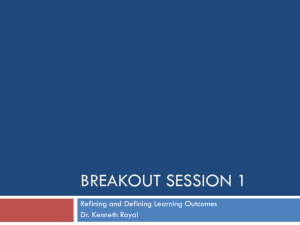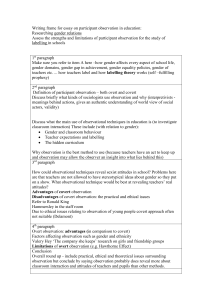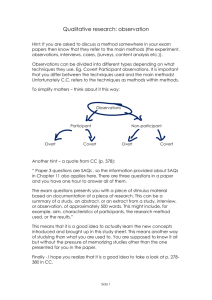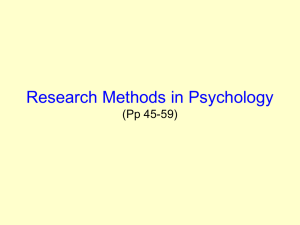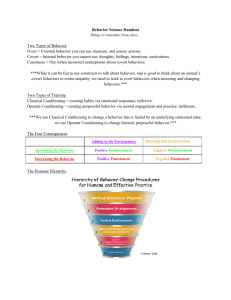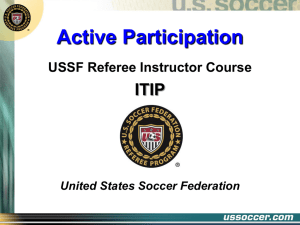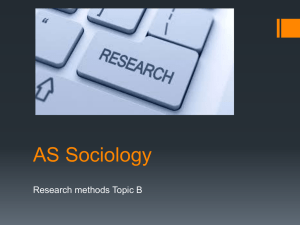Attention_AllParts
advertisement
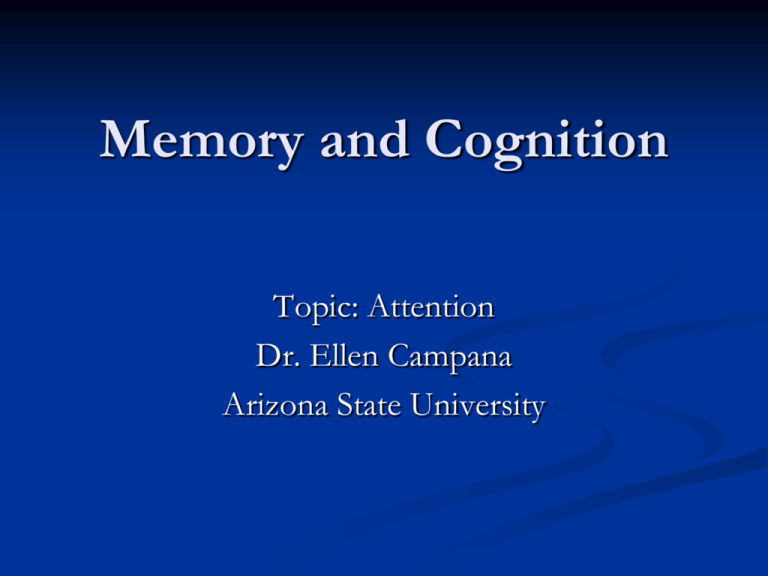
Memory and Cognition Topic: Attention Dr. Ellen Campana Arizona State University Attention Selective Attention vs. Divided Attention Automatic Processes vs. Controlled Processes High Cognitive Load vs. Low Cognitive Load Visual Attention Exogenous vs. Endogenous Direction of Attention Overt Attention vs. Covert Attention Overt: Bottom-up vs. Top-down control Covert: Location-based vs. Object-based Attention Vocabulary Selective Attention vs. Divided Attention Automatic Processes vs. Controlled Processes High Cognitive Load vs. Low Cognitive Load Visual Attention Exogenous vs. Endogenous Direction of Attention Overt Attention vs. Covert Attention Overt: Bottom-up vs. Top-down control Covert: Location-based vs. Object-based Selective Attention Part I Selective Attention “Everyone knows what attention is. It is the taking possession by the mind, in clear and vivid form, of one out of what seem like several simultaneously possible objects or trains of thought… It implies withdrawal from some things in order to deal effectively with others.” - William James (1890) Selective Attention Selective Attention: The ability to focus in on one message and ignore all others Attention is involved in many aspects of cognition Perception Memory Language Problem-Solving Dichotic Listening Blah blah blah blah blah… Blah blah blah blah blah… Dichotic Listening What does it feel like to shadow something??? Say exactly what the speaker is saying as quickly as you can. Don’t wait for him to finish – start doing it while he is still talking. Did you hear anything that was going on around you while doing it? Attention Models / Theories Early Models of Selective Attention Early Filter (Broadbent) Attenuator Model (Triesman) Late Filter Load Model (Lavie) Early Filter Model (Broadbent) Dichotic Listening Studies Cherry – participants could only report male / female voice (nothing about meaning) Moray – participants failed to notice a word repeated 35 times in the unattended ear Interpretation: Attention acts as a filter or bottleneck Attended information gets through Unattended information does not get through Early Filter Model (Broadbent) Messages Sensory Memory Filter Attended Message Detector To Memory Information processing model from chapter 1 Not physiological Attenuator Model (Triesman) Dichotic Listening Studies Moray – participants heard their own names in unattended ear (Cocktail party effect) Gray and Wedderburn – Dear Aunt Jane Dichotic Listening Dear 7 Jane Attended Ear or Attended Channel (Shadowing) Dear Aunt Jane 9 Aunt 6 Unattended Ear or Unattended Channel (Ignoring) Attenuator Model (Triesman) Dichotic Listening Studies Moray – participants heard their own names in unattended ear (Cocktail party effect) Gray and Wedderburn – Dear Aunt Jane Interpretation: Attention acts as a “leaky filter” Attended information is full strength Unattended information is attenuated (not blocked) Attenuator Model (Triesman) Unattended Message Messages To Memory Attenuator Attenuator Dictionary Unit Attended Message Uses whatever aspects of the messages are necessary in order to separate them (surface characteristics + meaning) Output = all messages, with the attended message being strongest (unattended messages attenuated) Attenuator Model (Triesman) Unattended Message Messages To Memory Attenuator Dictionary Unit Dictionary Unit Attended Message Contains all words, with different activation thresholds Common or important words have lower thresholds so it doesn’t take much to recognize them START HERE ELLEN! Late Filter Models Dichotic Listening Study McKay – Bank (River or Money) Dichotic Listening He threw stones at the bank. Attended Ear or Attended Channel (Shadowing) He threw stones at the bank. RIVER Unattended Ear or Unattended Channel (Ignoring) Dichotic Listening He threw stones at the bank. Attended Ear or Attended Channel (Shadowing) He threw stones at the bank. MONEY Unattended Ear or Unattended Channel (Ignoring) Late Filter Models Unattended ear: RIVER / MONEY Shadowed: They were throwing stones at the bank. Memory task (afterward) They threw stones toward the side of the river vs. They threw stones at the savings and loan association Late Filter Models Dichotic Listening Study McKay – Bank (River or Money) Interpretation: Much more processing (for meaning) much be happening before the filter Whole class of models about different mechanisms Detail beyond scope of this class Soon to end anyway Attention Models / Theories Early Models of Selective Attention Early Filter (Broadbent) Attenuator Model (Triesman) Late Filter Load Model (Lavie) Load-Dependent Processing (Lavie) There was a lot of evidence for each type of model, and no clear “winner” Lavie made a critical observation When tasks were difficult or stimuli were complex, experiments supported the early filter model When tasks were easy or stimuli were simple, experiments supported attenuator / late filter models Interpretation: Attention is Load-dependent Attention Vocabulary Selective Attention vs. Divided Attention Automatic Processes vs. Controlled Processes High Cognitive Load vs. Low Cognitive Load Visual Attention Exogenous vs. Endogenous Direction of Attention Overt Attention vs. Covert Attention Overt: Bottom-up vs. Top-down control Covert: Location-based vs. Object-based Cognitive Load Attention has limited capacity High-load tasks use all resources, leaving nothing for other tasks Low-load tasks use fewer resources, leaving some available for other things One way to study attentional load is by using a flanker compatibility task Flanker Compatibility Task Participants have to look for a particular target item within the circles (say it’s a square) Push a key whenever you see a square within the circle areas, as quickly as possible Ignore anything outside the circle areas (distractors) BUT keep eyes focused on the cross in the center Flanker Compatibility Task Flanker Compatibility Task Flanker Compatibility Task Flanker Compatibility Task Participants have to look for a particular target item within the circles (say it’s a square) Push a key whenever you see a square within the circle areas, as quickly as possible Ignore anything outside the circle areas (distractors) BUT keep eyes focused on the cross in the center Compatible distractors: same as target Incompatible distractors: different from target Flanker Compatibility Task It took less time for people to correctly respond when there was a compatible distractor What does that tell us about model of attention? LATE FILTER C = Compatible I = Incompatible Flanker Compatibility Task That was the low-load condition, because only one circle had an object in it that participants needed to compare against the target In the high-load condition, there are more objects that might be targets Task is harder, therefore consumes more resources Flanker Compatibility Task Flanker Compatibility Task Now people did NOT respond more quickly when there was a compatible distractor What does that tell us about model of attention? EARLY FILTER C = Compatible I = Incompatible Lessons from the Flanker Task Low load = late filter, High load = early filter When the task is easy, it becomes hard to ignore irrelevant information Just like Lavie’s theory predicts Resources left over, so unattended info leaks in When the task is hard, it becomes easy to ignore irrelevant information No resources left over, so unattended info does not interfere Reading and Coglab Now pause the video and re-read pages 82-91 in the book, from the start of the chapter to “Divided Attention” If you haven’t already done it, do the Stroop Experiment on Coglab Divided Attention Part II Attention Vocabulary Selective Attention vs. Divided Attention Automatic Processes vs. Controlled Processes High Cognitive Load vs. Low Cognitive Load Visual Attention Exogenous vs. Endogenous Direction of Attention Overt Attention vs. Covert Attention Overt: Bottom-up vs. Top-down control Covert: Location-based vs. Object-based Divided Attention Selective attention is the ability (or at least intention) to attend to just one thing Divided attention is the ability to pay attention to multiple things at once Driving while talking, listening to music, and thinking about what to do that day Walking and chewing gum Depends on: Practice, Task Difficulty Automatic Processing If you practice a task over and over it can become automatic Can be done without intention Consume few resources Can be combined with other tasks that do consume resources Reading for comprehension and taking dictation Impossible at first Could be done after 85 hours / 17 weeks of practice The Stroop Effect Name the colors out loud as fast as you can, going from left to right The Stroop Effect The Stroop Effect The Stroop Effect Which case was faster? Is naming colors automatic? How about reading? Automaticity & Intentionality Schneider and Shiffrin (1977) Consistent mapping condition Targets = numbers, distractors = letters Nothing both target and distractor INSERT VIDEO Consistent Mapping Condition Automaticity & Intentionality Schneider and Shiffrin (1977) Consistent mapping condition Targets = numbers, distractors = letters Nothing both target and distractor Became automatic (even with 4 in set) Automaticity & Intentionality Automaticity & Intentionality Schneider and Shiffrin (1977) Consistent mapping condition Targets = numbers, distractors = letters Nothing both target and distractor Became automatic (even with 4 in set) Varied mapping condition Targets = letters, distractors = letters Target in one trial could be distractor in the next Never became automatic INSERT VIDEO Varied Mapping Condition Automaticity & Intentionality Schneider and Shiffrin (1977) Consistent mapping condition Targets = numbers, distractors = letters Nothing both target and distractor Became automatic (even with 4 in set) Varied mapping condition Targets = letters, distractors = letters Target in one trial could be distractor in the next Never became automatic Automaticity and Task Difficulty Schneider and Shiffrin (1977) Consistent mapping condition Knew targets ahead of time, targets stayed the same Varied mapping condition Targets kept changing for every trial Automaticity and Task Difficulty Schneider and Shiffrin (1977) Consistent mapping condition (from before) Varied mapping condition Knew targets ahead of time, targets stayed the same Targets kept changing for every trial HARDER Varied mapping condition was too hard to become automatic Opposite of automatic… controlled processing Inattention and Driving 100-car Naturalistic Driving Study 82 crashes, 771 near-crashes Recorded view out front & back, plus what driver was doing For most of the accidents & near-accidents the driver was inattentive just beforehand Toronto traffic study Cell phones increased crash risk by 4x No advantage for hands-free cell phone Inattention and Driving Simulation Study Missed more red lights when talking Took longer to apply brakes when talking What is happening here? Having a conversation uses cognitive resources that could be used for driving Reading Now pause the video and re-read pages 91-95 in the book, from “Divided Attention” to “Attention and Visual Perception” Visual Attention Part III Attention Vocabulary Selective Attention vs. Divided Attention Automatic Processes vs. Controlled Processes High Cognitive Load vs. Low Cognitive Load Visual Attention Exogenous vs. Endogenous Direction of Attention Overt Attention vs. Covert Attention Overt: Bottom-up vs. Top-down control Covert: Location-based vs. Object-based Visual Attention There is a lot of research in the connection between vision and attention Usually need vision in order to attend Usually need attention in order to see Can be hard to think of as being separate! Not aware of everything we don’t see. Not aware of everything we don’t attend to Demos: Missing things that are right in front of our eyes… INSERT VIDEO MACKROCK INSERT VIDEO Umbrella INSERT VIDEO Change detect INSERT VIDEO ChangeBlindDoor INSERT VIDEO Scene Continuity Direction of Attention Scary to think of how much you might be missing, isn’t it? Not really as bad as it seems… these are experiments, after all. Other things going on in the world that keep it from being a problem Did were you sometimes “in control” of your attention while other times you found that it changed without you wanting it to? Attention Vocabulary Selective Attention vs. Divided Attention Automatic Processes vs. Controlled Processes High Cognitive Load vs. Low Cognitive Load Visual Attention Exogenous vs. Endogenous Direction of Attention Overt Attention vs. Covert Attention Overt: Bottom-up vs. Top-down control Covert: Location-based vs. Object-based Direction of Attention Endogenous control of attention You are in control of how your attention flows from one object to another (may miss unrelated things) “Endo” = Latin for “inside” Exogenous control of attention Attention can be drawn to things in environment (surprising things, bright things, important things, movements accompanied by sounds, etc.) “Exo” = Latin for “outside” Reading Now pause the video and re-read pages 95-98 in the book, from “Attention and Visual Perception” to “Overt Attention: Attention by Moving our Eyes” Attention Vocabulary Selective Attention vs. Divided Attention Automatic Processes vs. Controlled Processes High Cognitive Load vs. Low Cognitive Load Visual Attention Exogenous vs. Endogenous Direction of Attention Overt Attention vs. Covert Attention Overt: Bottom-up vs. Top-down control Covert: Location-based vs. Object-based Eye Movements and Attention We only see sharply and in color with the fovea of our eye Fovea is a really tiny region in the very center Eyes move all the time in order to see the world, most of the time “jumping” not “gliding” Fixation – the eyes stay looking at the same spot for about 1/3 of a second Saccade – rapid movement of the eye from one place to another Tracking Eye Movements Eye Camera Scene Camera Fixation Position Picture of an eyetracker Eye Movements What determines where an individual fixations? Attention Vocabulary Selective Attention vs. Divided Attention Automatic Processes vs. Controlled Processes High Cognitive Load vs. Low Cognitive Load Visual Attention Exogenous vs. Endogenous Direction of Attention Overt Attention vs. Covert Attention Overt: Bottom-up vs. Top-down control Covert: Location-based vs. Object-based Where the Eyes Move Determined by both bottom-up and top-down effects. Recall from before: Bottom-up: driven by the data coming into the eye Top-down: driven by our knowledge Bottom-up effects Stimulus salience – areas “stand out” to our perceptual system because of how they look… bright colors, high contrast, etc. Salience Salience There are just a few facts associated with salience A picture like we just saw is called a saliency map Used in experiments to make predictions about where the eyes will go If there’s a sudden change in saliency, the eyes (and attention) can be captured Salience isn’t the only thing – there are also topdown effects Top-down Eye Movement Control Scenes with meaningful elements Familiar scenes fixate on those meaningful elements Fixations influenced by perceiver’s scene schema (knowledge about what is contained in those scenes) Task-dependant information WHY you’re looking determines where you look Meaningful Elements and Scene Schemas Fixate on people because they’re meaningful Fixate on chair because it helps figure out what the room is (which Scene Schema) Task Dependancy (Yarbus, 1967) Different eye movement patterns when people were asked to do different tasks Eye Movements http://viperlib.york.ac.uk/ (keyword: eye movements or hayhoe) Attention Vocabulary Selective Attention vs. Divided Attention Automatic Processes vs. Controlled Processes High Cognitive Load vs. Low Cognitive Load Visual Attention Exogenous vs. Endogenous Direction of Attention Overt Attention vs. Covert Attention Overt: Bottom-up vs. Top-down control Covert: Location-based vs. Object-based Attention Without Fixation Posner & Coworkers (1980) Attention Without Fixation Posner & Coworkers (1980) FASTER Cue Matches Target Location (lots of these) Cue Mismatches Target Location (few of these) Attention Without Fixation Posner & Coworkers (1980) People were faster at detecting the lights when the cueing matched the target True even though their eyes were always fixated on the square People must have been attending to the location indicated by the cue, even without fixating there Object-based Visual Attention We have just seen how attention can be directed to particular areas in space (with or without fixation to that area) Called location-based attention Like a spotlight that shines on a particular area Contrasted with object-based attention In static scenes attention can be to an object In dynamic environments attention locks on to particular objects and follows them as they move Attention Vocabulary Selective Attention vs. Divided Attention Automatic Processes vs. Controlled Processes High Cognitive Load vs. Low Cognitive Load Visual Attention Exogenous vs. Endogenous Direction of Attention Overt Attention vs. Covert Attention Overt: Bottom-up vs. Top-down control Covert: Location-based vs. Object-based Object-Based Attention Egly & Coworkers (1994) FASTER Object-Based Attention Egly & Coworkers (1994) FASTER Object-Based Attention Egly & Coworkers (1994) Flash that occurred on the same object was faster than the on that occurred on the other object True despite the fact that both flashes were the same distance from the cued location True even when an occluder appeared in front of the objects Evidence that aspects of attention are objectbased, even for stationary objects. Object-based Attention Hemineglect House vs Normal House Object-based Attention YES NO Object-based Attention YES Reading Now pause the video and re-read pages 98-104 in the book, from “Overt Attention: Attention by Moving our Eyes” to “Feature Integration Theory” Feature Integration Theory Two stages of the visual process Preattentive Stage Automatic, effortless, unconscious Objects analyzed into independent features Focused Attention Stage Requires attention by the perceiver Features combine to form perception of whole object Evidence Pop-out effect and Illusory Conjunction studies Balint’s Syndrome Evidence for Features: Popout Yell “me” when you …… See the TILTED LINE Evidence for Features: Popout Evidence for Features: Popout Yell “me” when you …… See the VERTICAL LINE Evidence for Features: Popout Evidence for Features: Popout Yell “me” when you …… See the CLOSED CIRCLE Evidence for Features: Popout Evidence for Features: Popout Yell “me” when you …… See the CIRCLE WITH A GAP Evidence for Features: Popout Popout Tilted line among horizontal lines Vs. Horizontal line among tilted lines Circle with gap among closed circles Vs. Closed circle among circles with gaps Easier Easier Visual Search Times Time to Respond Number of distractors POP! Conclusions of Popout Studies Tilted line is a feature (vertical line is not) Gap is a feature (closed shape is not) Illusory Conjuctions 5 2 Illusory Conjunctions Green Triangle? Red Triangle? Red Circle? Black Circle? People misremember Shapes and color features combined wrong Effect goes away when ppl focus on shapes Effect goes away when shapes are meaningful Illusory Conjuctions 9 3 Illusory Conjunctions Green Triangle? Red Triangle? Red Circle? Black Circle? People misremember Shapes and color features combined wrong Effect goes away when ppl focus on shapes Effect goes away when shapes are meaningful Balint’s syndrome (parietal lobe damage) Inability to focus attention on objects See illusory conjunctions even with lots of time Reading Now pause the video and re-read pages 104-106 in the book, from “Feature Integration Theory” to “The Physiology of Attention” Physiology of Attention Part IV Attention Without Fixation Colby & Coworkers (1995) Fixation Condition: Fixate on the fixation light, release bar whenever fixation light dims IGNORE Attention Without Fixation Colby & Coworkers (1995) Fixation Condition: Fixate on the fixation light, release bar whenever fixation light dims Fixation And Attentin Condition: Fixate on the fixation light, release bar whenever peripheral light dims Attention Without Fixation Colby & Coworkers (1995) Monkeys could learn to do both tasks That in and of itself shows that attention and vision are not quite the same thing Cell in parietal cortex fired in response to the peripheral light Fired MORE in the fixation and attention condition, even though the image on the retina was exactly the same Reading Now pause the video and re-read pages 106-108 in the book, from “The Physiology of Attention” to “Something to Consider” Attention and Autism Part V Autism and Attention Autism – developmental disorder that includes withdrawal of contact from other people Difficulty understanding social cues, non-verbal communication, emotions of others Often normal (or even above average) IQ, though language ability is often impaired Klim & Coworkers (2003) – individuals with autism can reason about social situations but not understand them in day-to-day life Autism and Attention Klim & Coworkers (2003) Video – Who’s Afraid of Virginia Woolf? Emotional scene, after a character breaks a bottle Nonautistics focus on eyes to get emotional reaction (white in book) Autistics look off to the side (black in book) Character pointing across the room Nonautistics follow the gesture to see target, then face of another character Autistics look at things unrelated to the social event Ppl with autism don’t attend to social cues Autism and Attention Does inattention to social cues “cause” the social deficits? NO, but they contribute Feedback loop Negative emotions influence eye-movements & attention Eye-movement & attention differences influence how well they understand How well they understand influences how well the perform Autism and Attention There might be other things going on, too. Silverman & Coworkers (including Campana) – individuals with autism have difficulty putting together verbal and nonverbal information even when they see and hear all of it Reading Now pause the video and re-read the remainder of the chapter. THE END
